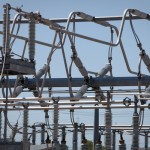How Wind Energy Can Power Desalination in Texas

Photo courtesy of Webber Energy Group
UT graduate student Mary Clayton has come up with an innovative approach for using wind to power desalination
Texas’ energy problems seem to be piling up more and more each day. The electric grid is strained, the drought persists (although things have improved), and alternative energy and water production models come across as financially and logistically difficult to implement in the middle of a recession. But with these myriad problems also comes the opportunity for innovation.
One graduate student at the University of Texas at Austin (UT) is an example of that innovation. Mary Clayton, has come up with a model that may help Texas overcome both its water and electricity problems in one fell swoop. The plan involves using wind energy produced at night to power desalination of brackish ground water in West Texas. Recently some lawmakers have incorporated desalination into their energy reform policies, yet many have criticized it as a costly and energy-intensive process. But what if there was a way to use excess wind to power it?
Windy nights, copious brackish ground water, and high levels of drought make West Texas towns like Lubbock, Abilene, and Midland the perfect location for such an experiment. Clayton, a National Science Foundation Graduate Research Fellow in Mechanical Engineering, presented these findings at a recent symposium of the Webber Energy Group, an interdisciplinary research group at UT that focuses on energy problems. Their goal is to bridge the gap between engineering, science, and the general public. Clayton recently sat down with me to discuss her solution for making desalination affordable and renewable.
Q: Can you give us a basic explanation of your plan?
A: My research looks at using wind power for brackish ground water desalination in West Texas. Cities are running out of water and are going to have to be turning to new water sources such as desalination. But an issue with that is that it’s a very energy-intensive process, which is kind of counterproductive to our goal of reducing emissions. So one way to deal with that is to use wind power. The opposite side of that is that we’re increasing our wind installations [but] wind is mostly available at night when we don’t need it. So a solution to that is energy storage or some sort of technology that can use the power at night less intermittently. So one of our big ideas is, instead of energy storage, why not use water desalination? And that solves two problems.
Q: This plan is mainly for Texas, correct?
A: Our analysis just looked at Texas, specifically West Texas. You can do this, obviously, on the coast with seawater. We looked at brackish groundwater in Texas because there are a lot of brackish water wells and a lot of windmills in West Texas. But you can really do this anywhere where you have the resources available.

Graphic courtesy of Mary Clayton
A slide from Clayton's presentation shows the profitability of her plan.
Q: Is there a difference between brackish water and ocean water that makes brackish water more suitable for desalination?
A: Yes. Brackish water has a lot less total dissolved solids than seawater, so it’s less energy-intensive and has a better recovery. So, if you have a reverse osmosis facility on the coast, for every 100,000 gallons of seawater, you’d only produce 50,000 gallons of freshwater, and the rest would be brine that you’d put back into the ocean. With brackish groundwater, you have a higher recovery rate. So for every 100,000 gallons you take in, you would produce about 70-80,000 gallons of freshwater, and it takes less energy because you have to pull fewer solids out of the water. But the negative of the inland desalination is that you do have that brine [to] dispose of – you can’t just put it back into the ocean – so you have to use stuff like evaporative ponds and deep-well injection – which adds a large expense to your system. So it’s kind of a trade-off.
Q: You mention that there has been a rise in the number of turbines constructed. Is the state funding the construction of these windmills more now that this project is becoming possible for the first time?
A: Part of what this funding from the government is [that] they get a production tax credit. So for every kilowatt hour they produce, they get 2.1 cents per kilowatt hour. But one of the issues is that wind is [mostly] available at night. So how electricity is bought on the grid is by the hour, so electricity is most expensive – not for the consumer, but for the utility – during the day. So when wind’s available at night the electricity prices are actually negative. But those windmills are still selling their electricity to the utilities at night for negative prices so they’ll still get that production tax credit. So if they can sell their electricity to a desalination plant for a positive rate, it’ll be a lot more lucrative of a business model.
Q: As a researcher are you forced to think about the economic side of your conclusions? Do you always feel like you have to cite, for example, how many jobs your plan will create, or how much state funding it would require? Is that a standard part of the equation nowadays?
A: I would say in engineering in general, a lot of groups don’t necessarily take it there, they’re looking more at the technical side. But in the Webber Group that’s really a lot of our focus: looking at the economics and the public policy and the real world application of this. So not just digging into the technology, but kind of looking at its applications and the public policy and economic aspects of it.
Q: Do you get the sense that more people in engineering departments are moving towards green energy projects?
A: I think students are definitely more interested in green energy projects. I know the business school has a new green energy group. So yes, I think universities are definitely picking up on this and starting new programs and new research groups that look into green energy projects.
Q: What’s the next step for you in regards to the desalination model?
A: We have two conference papers on the wind desalination project and a couple of presentations, so the last step is to turn it into a journal paper. Hopefully that will kind of wrap that up.

